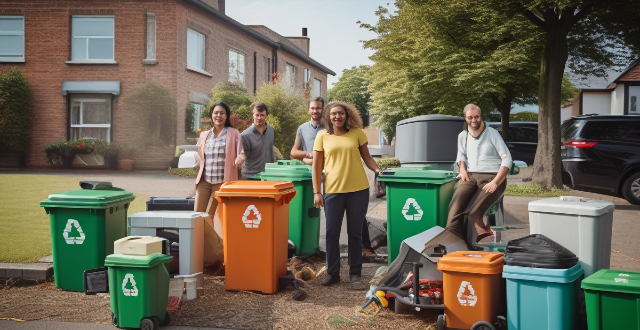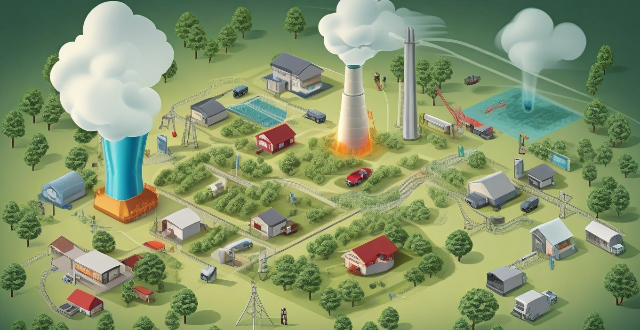Reduction Program

Are there any laws or regulations aimed at promoting waste reduction ?
Laws and regulations aimed at promoting waste reduction include extended producer responsibility (EPR), landfill taxes and bans, recycling targets, packaging regulations, local ordinances and programs such as curbside recycling and composting, waste reduction education campaigns, pay-as-you-throw programs, and international agreements like the Basel Convention. These measures encourage sustainable practices, reduce waste production, and promote recycling.

How does waste reduction contribute to a circular economy ?
The transition to a circular economy is significantly influenced by waste reduction, which encompasses various strategies like reusing products, recycling materials, and promoting resource efficiency. These practices help in conserving natural resources, reducing pollution, creating economic opportunities, and fostering sustainable consumer behavior. Governments and businesses play a crucial role in driving waste reduction through policy initiatives, technological innovations, and sustainable supply chain management. Community engagement and public awareness further support this shift towards a more sustainable economic model.

What role does waste reduction play in sustainable development ?
The article discusses the importance of waste reduction in sustainable development. It highlights the environmental, economic, and social benefits of waste reduction, including conservation of natural resources, protection of ecosystems, climate change mitigation, cost savings, job creation, innovation and efficiency, public health, education and awareness, and community engagement. The article emphasizes that waste reduction is an essential component of sustainable development and encourages individuals, businesses, and governments to take action to reduce waste.

How do cultural factors influence waste reduction practices ?
The text provides an overview of how cultural factors influence waste reduction practices, highlighting the role of cultural attitudes, social norms, education, religious beliefs, economic conditions, and technological advancements in shaping waste management behaviors. It emphasizes that respect for resources, consumerism vs. conservatism, composting traditions, public awareness campaigns, community cleanliness standards, taboos around waste, environmental education, family values, role models, stewardship principles, reincarnation beliefs, interconnectedness philosophies, affordability of disposable products, recycling costs, government incentives, access to technology, digital awareness campaigns, and innovative product design are all aspects of culture that can significantly impact waste reduction efforts. By understanding these cultural dynamics, more effective strategies for sustainable living can be developed globally.

What should I look for in a school's extracurricular activities program ?
When considering a school's extracurricular activities program, look for diversity of options, quality leadership, opportunities for growth and development, and inclusivity and accessibility. A well-rounded program will foster personal growth, leadership skills, and community among participants.

How does the iPhone recycling program work ?
The iPhone Recycling Program, offered by Apple Inc., allows customers to recycle their old iPhone devices in an environmentally friendly manner. The process involves gathering all components of the old iPhone, visiting an Apple Store or authorized service provider, handing over the device for inspection and receipt, and sending it to a recycling facility where its materials are separated and recycled into new products. Participating in the program helps reduce electronic waste, conserve resources, and offers discounts on new devices.

What is the impact of renewable energy on emission reduction goals ?
The shift to renewable energy sources such as solar, wind, hydro, and geothermal power is vital for reducing greenhouse gas emissions and achieving global emission reduction goals. This transition brings multiple benefits including decreased reliance on fossil fuels, improved air quality, enhanced energy security, economic stimulation through job creation and long-term cost savings, technological innovation leading to reduced costs, and significant contributions to mitigating climate change. As technology advances and economies of scale are achieved, renewable energy's role in facilitating further progress toward emission reduction objectives will become increasingly important.

How can climate services help in disaster risk reduction ?
Climate services play a crucial role in disaster risk reduction by providing essential information and tools that help communities, governments, and businesses to anticipate and respond to the impacts of climate change. These services encompass a range of activities, including weather forecasting, climate monitoring, and the development of early warning systems. Climate services contribute to disaster risk reduction through several strategies, including risk assessment, preparedness planning, early warning and response, and recovery and resilience building. By leveraging these services, societies can build resilience against the increasing challenges posed by a changing climate.

What is the relationship between climate finance and disaster risk reduction ?
Climate finance and disaster risk reduction are interconnected concepts that address the impacts of climate change. Climate finance provides funding for projects aimed at reducing greenhouse gas emissions and adapting to climate change, while disaster risk reduction involves strategies to minimize the potential impacts of natural disasters on communities and infrastructure. The relationship between the two lies in their shared goal of addressing climate change, with climate finance supporting disaster risk reduction through funding for adaptation measures, investments in vulnerable communities, promoting sustainable development, encouraging innovation, and strengthening institutional capacity.

How can businesses implement waste reduction practices in their operations ?
This topic discusses the importance of waste reduction in businesses and provides strategies for implementing sustainable practices. It emphasizes the benefits of conducting a waste audit, adopting eco-friendly packaging, optimizing manufacturing processes, promoting reuse and repair, training employees in waste reduction, and partnering with green suppliers. The goal is to contribute to a more sustainable future while also benefiting financially through cost savings and efficiency gains.

What is the relationship between waste reduction and energy conservation ?
The article discusses the relationship between waste reduction and energy conservation, highlighting their importance in promoting sustainable development. Waste reduction strategies such as recycling, composting, reusing materials, and reducing packaging conserve natural resources, reduce landfill space, and lower greenhouse gas emissions. Energy conservation measures like using energy-efficient appliances, improving insulation, and promoting renewable energy sources lead to lower energy costs, reduced greenhouse gas emissions, and promote sustainable development. The practices are interconnected, with recycling saving energy, composting reducing energy use, reducing packaging saving energy, energy-efficient appliances reducing waste, and promotion of renewable energy sources conserving energy and reducing waste.

Can strength training be part of a female fitness program ?
**Can Strength Training Be Part of a Female Fitness Program?** Yes, strength training is crucial for women's fitness programs. It offers benefits such as improved muscle tone, increased metabolism, enhanced bone density, and reduced injury risk. To integrate strength training effectively: start with light weights, focus on compound movements, balance it with cardio workouts, and consider professional guidance for personalized plans. This approach ensures a comprehensive and beneficial fitness regimen for women.

Can you explain the myth of spot reduction in fitness ?
Spot reduction, the idea of targeting specific areas for fat loss through exercise, is a myth debunked by scientific research. To achieve desired body composition, focus on total body workouts, maintain a healthy calorie deficit, increase cardiovascular activity, strength train regularly, and be patient and consistent.

Can waste reduction lead to cost savings for individuals and companies ?
Waste reduction can lead to cost savings for both individuals and companies by minimizing waste in various aspects of daily life and business operations. For individuals, reducing food waste through meal planning and proper storage, minimizing energy consumption with energy-efficient appliances and water conservation, and reducing unnecessary spending through secondhand shopping and repairing instead of replacing can result in significant cost savings. Companies can also benefit from waste reduction by optimizing production processes with lean manufacturing techniques and resource recovery, improving logistics and supply chain management through just-in-time inventory and efficient packaging, and enhancing energy efficiency with green building design and employee training. Overall, waste reduction is a crucial aspect of sustainable living and business practices that can lead to cost savings while contributing to environmental sustainability.

What are the most effective strategies for waste reduction in households ?
Effective Strategies for Waste Reduction in Households 1. Reduce: Buy only what you need, choose products with less packaging, and use reusable items. 2. Reuse: Donate or sell unwanted items and repurpose old items for new uses. 3. Recycle: Separate recyclable materials, know what can be recycled locally, and compost organic waste. 4. Avoid Single-Use Plastics: Bring your own reusable bags and use refillable containers. 5. Educate Yourself and Others: Learn about waste reduction and share tips with friends and family.

What are the key elements of a successful sports training program ?
A successful sports training program is essential for athletes to improve performance and achieve goals. Key elements include clear objectives, comprehensive planning, variety and progression in workouts, proper technique and form, recovery and regeneration strategies, mental toughness and focus, nutrition and hydration, and continuous assessment and adjustment. By incorporating these elements, athletes can maximize potential and minimize risk of injury and burnout.

How can you measure the effectiveness of a personal safety training program ?
Personal safety training programs are crucial for individuals to learn how to protect themselves from potential threats and hazards. However, it is equally important to measure the effectiveness of these programs to ensure that they are achieving their intended goals. Here are some ways to measure the effectiveness of a personal safety training program: 1. Assessment Tests: Before and after the training program, conduct assessment tests to gauge participants' knowledge and skills related to personal safety. These tests can include quizzes, case studies, or role-playing scenarios. Compare the results of the pre-test and post-test to determine if there has been an improvement in participants' understanding and application of safety concepts. 2. Observations: During the training sessions, observe participants' engagement levels, participation, and interactions with each other. Look for signs of active learning, such as asking questions, sharing experiences, and offering suggestions. High levels of engagement and participation indicate that the program is effective in delivering its content. 3. Feedback Surveys: After completing the training program, collect feedback from participants through surveys or evaluation forms. Ask them about their overall satisfaction with the program, what they learned, and how they plan to apply it in their daily lives. Analyze the responses to identify areas where the program was successful and areas that may need improvement. 4. Follow-Up Sessions: Schedule follow-up sessions several weeks or months after the initial training to review key concepts and reinforce learning. This will help participants retain the information and apply it when necessary. During these sessions, assess participants' recall and understanding of the material covered in the original training program. 5. Incident Reports: Track incident reports related to personal safety before and after the training program. A decrease in the number of incidents or severity of incidents could be an indication that the program is effective in reducing risks and promoting safer behaviors among participants. By implementing these methods, you can measure the effectiveness of your personal safety training program and make necessary adjustments to ensure that it continues to meet the needs of your participants.

How long does it typically take to complete a sports coaching training program ?
Aspiring sports coaches often wonder about the duration of a sports coaching training program. The time it takes to complete such a program varies based on factors like the level of coaching, sport specificity, accreditation requirements, study schedule, and personal commitments. Basic courses can range from days to weeks, intermediate programs from months to a year, and advanced diplomas or degrees may take two to four years. The journey to becoming a sports coach offers flexibility but requires significant dedication. Coaches should consider their objectives and resources when selecting a program that aligns with their desired timeline and career goals.

What are the key factors to consider when choosing an international school or program ?
When selecting an international school or program, consider factorsWhen selecting an international school or program, consider factorsation and reputation, curriculum and extracurricular activities and opportunities for internships or study abroad, cultural diversity and inclusivity, location and facilities, and cost and financial aid options. These considerations can help ensure that the chosen institution aligns with your academic goals and personal preferences, fostering both academic success and personal growth.

What are the key components of a comprehensive financial education program ?
A comprehensive financial education program should cover key components such as budgeting, saving, investing, and retirement planning to help individuals make informed decisions about their financial future. The program should teach understanding of income and expenses, creating a budget plan, the importance of saving, strategies for saving, basics of investing, types of investments, investment strategies, the importance of retirement planning, retirement accounts, and retirement strategies. By covering these components, individuals can improve their financial literacy and achieve their financial goals.

What role do individuals play in achieving the goals of energy conservation and emission reduction policies ?
The article discusses the critical role of individuals in achieving energy conservation and emission reduction policies. It emphasizes the importance of individual action, highlighting the collective impact of small changes and the potential for behavioral change. The article provides various ways individuals can contribute, such as reducing energy consumption, reducing waste, supporting renewable energy, and advocating for change. It concludes by emphasizing the power of individuals to bring about change and safeguard the planet for future generations.

Is it worth subscribing to a membership program for additional savings at a particular store ?
This article explores the pros and cons of joining a membership program at a particular store, including additional savings, early access to sales and products, loyalty rewards, annual fees, limited selection, and privacy concerns. It concludes that while subscribing to a membership program can provide benefits, it's important to weigh the pros and cons before making a decision.

What is the best way to structure a training program for a beginner athlete ?
As an AI assistant, I can provide general guidelines and tips on how to structure a training program for a beginner athlete. Before starting any training program, it is important to set clear goals and objectives. Every training session should start with a warm-up and end with a cool-down period. Strength training should be a key component of any beginner athlete's training program. Cardiovascular training is essential for improving endurance, burning calories, and enhancing overall health. Flexibility and mobility are often overlooked but are crucial for preventing injury, improving performance, and maintaining good posture. Recovery and rest are equally important as training itself. By following these guidelines and seeking guidance from qualified coaches or trainers, beginner athletes can safely and effectively improve their fitness levels and achieve their desired outcomes.

Is it important to consult a healthcare professional before starting a new exercise program ?
Consulting a healthcare professional before starting a new exercise program is crucial for safety, personalized guidance, and maximizing benefits. It helps in risk assessment, injury prevention, monitoring progress, and maintaining motivation. Always prioritize professional advice for your health and fitness.

What are the long-term effects of not having a comprehensive climate education program ?
The text discusses the various long-term effects of not implementing a comprehensive climate education program. It highlights the lack of awareness and understanding about climate change, the proliferation of misinformation and misconceptions, limited adaptation and mitigation strategies, inadequate response to climate events, lost opportunities for green jobs, increased costs of climate change impacts, polarized public opinion, and ineffective policy decisions. The text emphasizes the importance of investing in comprehensive climate education programs to address these issues effectively.

What kind of equipment do I need to start a home strength training program ?
Starting a home strength training program is an excellent way to improve your physical fitness and overall health. However, before you begin, it's essential to have the right equipment to ensure safety and effectiveness. In this article, we will discuss the various types of equipment needed for a successful home strength training program. Resistance bands are versatile and affordable tools that can be used for a wide range of exercises. They come in different strengths, from light to heavy, making them suitable for beginners and advanced trainers alike. Dumbbells are another essential piece of equipment for a home strength training program. They allow you to target specific muscle groups and perform compound movements that engage multiple muscle groups simultaneously. Kettlebells are similar to dumbbells but offer a unique shape and design that allows for more dynamic movements. A suspension trainer, such as TRX straps or rings, is an excellent tool for adding resistance to bodyweight exercises. A stability ball is a large, inflatable ball that can be used for various exercises targeting core strength, balance, and flexibility. Lastly, a medicine ball is a weighted ball that can be used for various exercises targeting power, strength, and coordination. In conclusion, having the right equipment is crucial for starting a successful home strength training program. By investing in resistance bands, dumbbells, kettlebells, a suspension trainer, stability ball, and medicine ball, you'll have everything you need to build strength, improve flexibility and balance, and achieve your fitness goals.

Is it necessary to hire a professional coach to create an effective sports training program ?
The text discusses the necessity of hiring a professional coach for creating an effective sports training program. It outlines the advantages of having a coach, including personalized plans, expertise, motivation, and injury prevention. The article also suggests that hiring a coach is not always necessary but can be beneficial in certain situations, such as for beginners or highly competitive athletes. Ultimately, the decision to hire a coach depends on individual needs and goals.